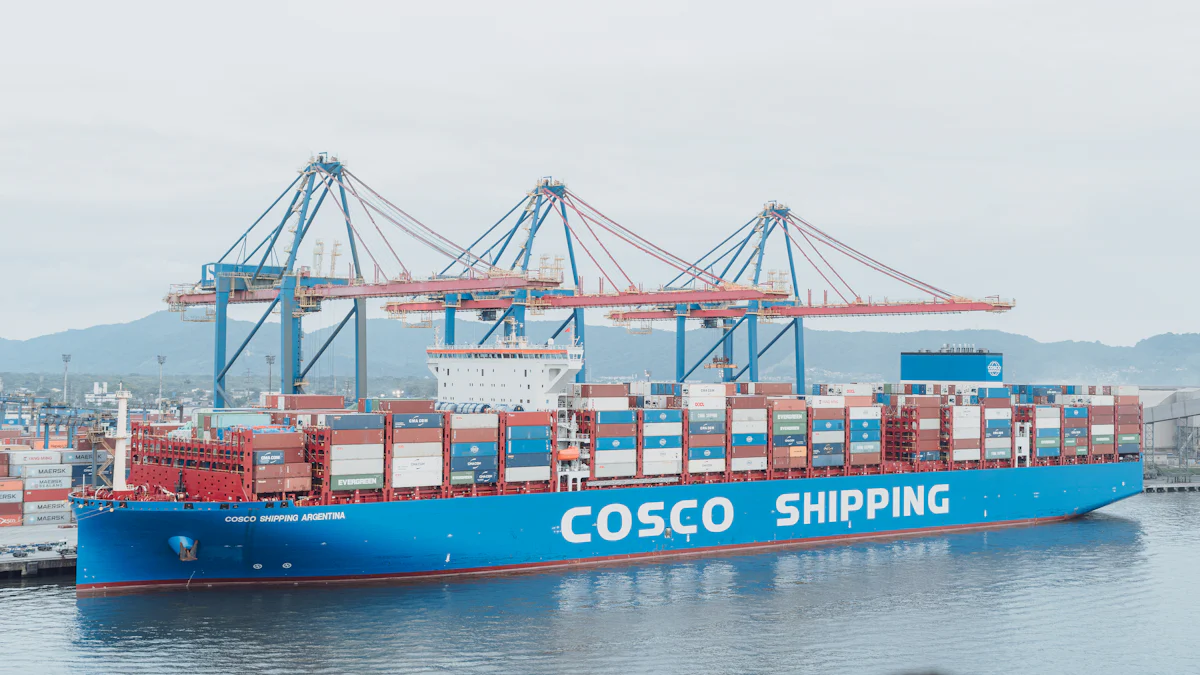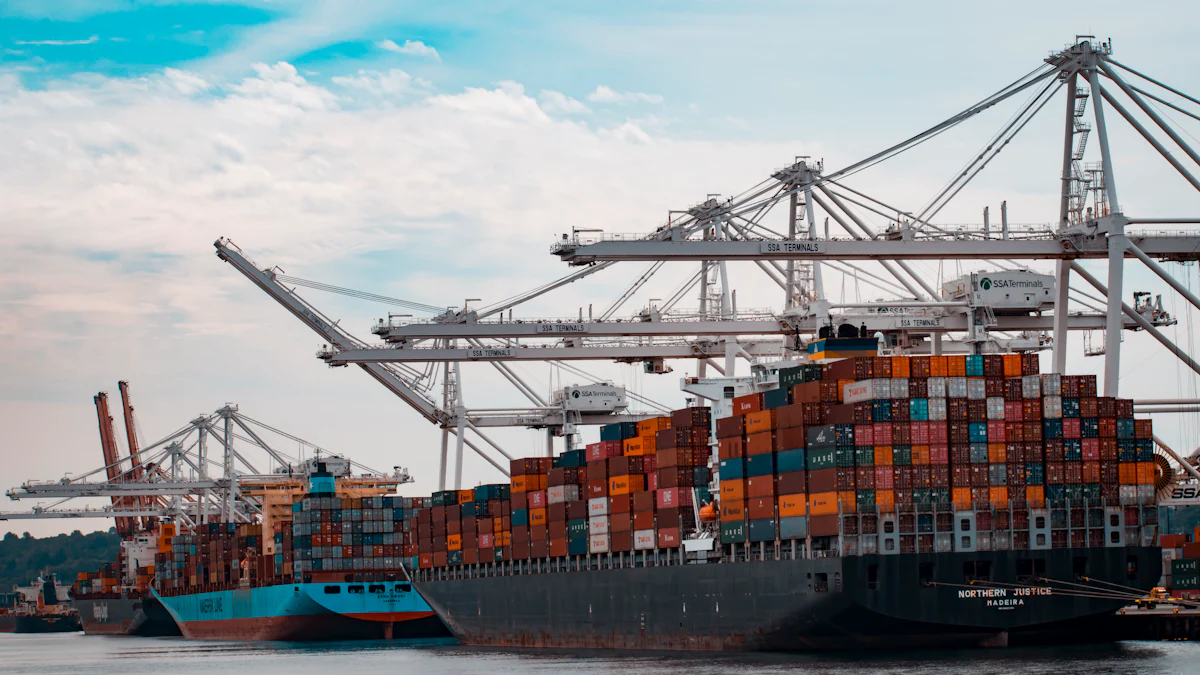The Carbon Border Adjustment Mechanism (CBAM) presents a critical challenge for Chinese exporters targeting the EU market. By 2026, less than 2% of China’s exports to the EU—valued at approximately €6.5 billion—could face CBAM regulations. Non-compliance risks are significant: higher costs, market access loss, reputational damage, and potential sanctions. These consequences could disrupt your operations and growth. Proactive preparation is essential. Building a strategy for CBAM compliance will help you safeguard your market position and maintain competitiveness in the EU.
Key Takeaways
- Learn CBAM rules to avoid fines. Reporting emissions correctly is key.
- Use energy-saving tools to cut carbon emissions. Better machines save money and help compete.
- Take advantage of government help like subsidies and tax breaks. This can make switching to greener methods easier.
- Work with EU buyers and carbon experts. Teamwork can make following rules simpler and improve sustainability.
- Start early by setting up a strong carbon tracking system. Collecting accurate data on time is very important for CBAM.
Understanding CBAM Compliance
Key Components of CBAM Regulations
To comply with CBAM regulations, you must focus on several critical components. First, you need a robust monitoring methodology to track carbon emissions accurately. This includes a detailed description of your manufacturing processes to ensure all emissions are accounted for. Additionally, you must follow the greenhouse gas (GHG) emissions accounting methodology outlined by CBAM.
Verification is another essential step. All emissions data must be validated by accredited third-party auditors. Importers are also required to submit quarterly reports, with the first deadline set for January 31, 2024. These steps ensure transparency and accountability, which are central to CBAM Compliance.
Implications for Chinese Exporters
CBAM introduces both challenges and opportunities for Chinese exporters. You may face difficulties in reporting and disclosing carbon emissions data. Many exporters need to enhance their carbon reporting systems and improve data verification processes. Accurate measurement of carbon content in your products is essential to meet CBAM standards.
The regulations also impact your cost structure. High-carbon industries will see increased operational costs due to carbon pricing. To remain competitive, you may need to invest in cleaner technologies and energy-efficient practices. While the direct trade effects of CBAM are minimal, industries relying on fossil fuels could face disadvantages. Transitioning to low-carbon operations can help you adapt to these changes.
Timeline and Transitional Period Requirements
CBAM follows a phased implementation timeline. Here are the key milestones:
| Date | Milestone Description |
|---|---|
| 1 October 2023 | CBAM entered its transitional phase, with reporting requirements starting. |
| 31 December 2025 | End of the transitional period where only reporting of emissions is required. |
| 1 January 2026 | Start of incremental rollout where CBAM payments will be required for some imported goods. |
| 1 January 2034 | Full implementation of CBAM requiring both reporting and payments for all CBAM goods. |
During the transitional period (October 2023–December 2025), you must report emissions without making payments. Starting in 2026, CBAM will gradually expand to include payments for certain goods. By 2034, full implementation will require both reporting and payments for all covered products. Preparing early will help you navigate these changes smoothly.
Enhancing Carbon Reporting
Importance of Accurate Emissions Data
Accurate emissions data plays a critical role in meeting CBAM Compliance requirements. It ensures transparency and helps you avoid penalties for non-reporting or inaccuracies, which will be enforced starting in 2027. Inaccurate reporting can lead to financial losses from fines and reputational damage due to regulatory scrutiny.
You must track both direct and indirect emissions across your production and supply chains. This includes calculating the carbon footprint embedded in your products. Tools like Makersite can help you achieve this by providing product-specific emissions data. Reliable data not only supports compliance but also ensures a level playing field in the market. Misreporting emissions can result in unfair competitive advantages and hinder global climate goals.
Tools and Frameworks for Carbon Reporting
To streamline carbon reporting, you need to adopt the right tools and frameworks. Digital platforms designed for emissions tracking can simplify data collection and analysis. These tools allow you to monitor emissions at every stage of your supply chain. They also help you synchronize data for quarterly CBAM reports.
Frameworks like the Greenhouse Gas Protocol provide standardized methods for measuring emissions. These frameworks ensure consistency and accuracy in your reporting. By integrating these tools and frameworks, you can build a robust system that meets CBAM requirements and supports long-term sustainability goals.
Steps to Build a Reliable Reporting System
Building a reliable carbon reporting system involves several key steps:
- Allocate responsibilities by identifying individuals or departments to oversee CBAM-related tasks.
- Assess the impact of CBAM on your products and determine the embedded emissions.
- Collect emissions data from internal sources and suppliers.
- Identify data gaps, especially for indirect emissions, and address them.
- Review your existing technology and invest in tools that automate data collection and reporting.
- Create a CBAM reporting action plan to ensure timely and accurate quarterly submissions.
Additionally, consider automating processes to reduce errors and improve efficiency. Conduct regular risk assessments to identify potential areas of non-compliance. These steps will help you establish a system that not only meets CBAM Compliance standards but also enhances your operational efficiency.
Transitioning to Greener Production

Assessing Current Carbon Footprint
Understanding your current carbon footprint is the first step toward greener production. You need a clear picture of the emissions generated throughout your value chain. The economic input-output life-cycle assessment (EIO-LCA) method can help you achieve this. This approach traces carbon emissions across all stages of production. It integrates the hypothetical extraction method (HEM) with a unified input-output framework. This combination captures emissions from pre-production to post-production. By using this method, you can evaluate the carbon emissions embedded in your products more comprehensively.
Start by gathering data on your raw materials, energy use, and production processes. Analyze this data to identify high-emission areas. This assessment will guide your decisions on where to focus your reduction efforts. A detailed understanding of your carbon footprint ensures you align with CBAM Compliance requirements and positions you for long-term sustainability.
Investing in Energy-Efficient Technologies
Energy-efficient technologies can significantly reduce your carbon emissions. Upgrading outdated machinery and optimizing production processes are effective ways to cut energy consumption. For example, switching to high-efficiency motors or implementing smart manufacturing systems can lower your energy use. These investments not only reduce emissions but also lower operational costs over time.
You should also explore advanced technologies like heat recovery systems or energy-efficient lighting. These solutions can make your production processes more sustainable. Regularly auditing your energy use will help you identify areas for improvement. By adopting these technologies, you can enhance your competitiveness in the EU market while meeting environmental standards.
Adopting Renewable Energy Solutions
Renewable energy solutions offer a powerful way to transition to greener production. Many Chinese companies are already leading the way. For instance:
- JinkoSolar plans to fully adopt renewable energy by 2030, aiming for a 58.2% reduction in emissions per megawatt of solar products by 2032.
- Sunwoda focuses on material recycling and aims to achieve carbon neutrality by 2050. The company targets a reduction of 6.84 million tons of societal carbon emissions by 2030.
You can follow similar strategies by integrating renewable energy sources like solar or wind into your operations. Partnering with suppliers who prioritize sustainability can further enhance your efforts. These steps not only reduce your carbon footprint but also strengthen your reputation as a responsible exporter.
Leveraging Government Support
Chinese Policies Supporting CBAM Compliance
The Chinese government has introduced several policies to help you align with CBAM requirements. Stricter environmental regulations are being enforced to meet EU standards. These policies encourage manufacturers like you to reduce the carbon intensity of your products. Key growth areas include industries focused on lowering emissions and improving energy efficiency.
China’s national carbon trading scheme, launched in 2021, is another significant initiative. This program allows you to trade carbon credits, incentivizing emission reductions. By participating, you can offset your carbon footprint and align with international carbon pricing mechanisms. These policies aim to support your transition to sustainable practices while maintaining competitiveness in the EU market.
Subsidies and Incentives for Exporters
You can take advantage of subsidies and incentives designed to ease your transition to greener production. The government offers financial support for adopting energy-efficient technologies and renewable energy solutions. These subsidies can help you upgrade your equipment or invest in cleaner production methods.
Tax incentives are also available for businesses that prioritize sustainability. For example, you may qualify for reduced tax rates if you implement carbon reduction strategies. Additionally, grants are often provided for research and development in low-carbon technologies. These incentives not only reduce your costs but also accelerate your journey toward CBAM Compliance.
Collaborating with Local Authorities
Local authorities play a crucial role in supporting your compliance efforts. You should engage with them to access resources and guidance tailored to your industry. Many local governments offer training programs to help you understand CBAM requirements and improve your carbon reporting systems.
Collaboration can also help you navigate regulatory changes more effectively. By working closely with local authorities, you can stay informed about new policies and opportunities. This partnership ensures you remain compliant while benefiting from government support. Building strong relationships with local officials can streamline your transition to sustainable practices.
Building Strategic Partnerships

Collaborating with EU Importers
Collaborating with EU importers can help you navigate CBAM Compliance effectively. These partnerships offer several advantages:
- Cost Savings: Working with importers ensures accurate emissions reporting, helping you avoid carbon tariffs and related expenses.
- Market Access: Maintaining strong relationships with EU importers secures uninterrupted access to the EU market, protecting your customer base and revenue streams.
- Competitive Advantage: Early compliance positions you as a sustainability leader, attracting eco-conscious customers and enhancing your reputation.
Engage with your EU partners to align on emissions data and reporting standards. This collaboration ensures transparency and builds trust, which is essential for long-term success in the EU market.
Tip: Regular communication with your EU importers can help you stay updated on regulatory changes and adapt quickly.
Partnering with Carbon Management Experts
Carbon management experts can guide you through the complexities of CBAM regulations. Their expertise helps you evaluate supply chain emissions and identify potential costs. They can also assist you in collaborating with low-carbon suppliers to reduce emissions and liabilities.
These professionals provide pre-verification services to prepare you for mandatory compliance starting in 2026. They assess your emissions monitoring systems, identify errors, and offer actionable insights. By working with them, you can ensure your readiness for CBAM’s verification requirements.
Additionally, carbon management experts can recommend investments in low-carbon technologies. These investments lower direct emissions from production and align with China’s national carbon neutrality goals. Their support not only simplifies compliance but also strengthens your sustainability efforts.
Joining Industry Alliances for Shared Resources
Industry alliances offer a platform for shared learning and resource pooling. By joining these groups, you can access best practices, tools, and frameworks tailored to CBAM Compliance. These alliances often include companies facing similar challenges, creating opportunities for collaboration.
Shared resources can reduce the cost of compliance. For example, alliances may provide access to emissions tracking software or training programs. These resources help you build robust systems without incurring high expenses.
Note: Participating in industry alliances also enhances your credibility. It demonstrates your commitment to sustainability and positions you as a proactive player in the global market.
Building strategic partnerships ensures you stay ahead in the evolving regulatory landscape. These collaborations strengthen your compliance efforts and enhance your competitiveness in the EU market.
Preparing for CBAM Compliance requires a clear strategy. Focus on these five key actions:
- Identify your responsibilities by mapping applicable goods and their value chain positions.
- Communicate with your value chain to ensure everyone understands CBAM requirements.
- Build a system for data collection and disclosure to support compliance.
- Transition to greener production by adopting energy-efficient and renewable solutions.
- Leverage government support and partnerships to strengthen your efforts.
Early preparation ensures you avoid penalties and maintain your EU market position. Act now to secure your competitive edge and align with global sustainability goals.
FAQ
What is CBAM, and why does it matter for Chinese exporters?
CBAM stands for Carbon Border Adjustment Mechanism. It is an EU policy that imposes carbon pricing on imported goods. For Chinese exporters, it ensures fair competition with EU producers and encourages greener production. Non-compliance can lead to higher costs and restricted market access.
Which industries are most affected by CBAM?
CBAM primarily impacts high-carbon industries like steel, cement, aluminum, fertilizers, and electricity. If your business operates in these sectors, you must prioritize emissions reporting and adopt low-carbon technologies to meet compliance requirements.
How can I calculate the carbon footprint of my products?
You can use tools like the Greenhouse Gas Protocol or life-cycle assessment (LCA) methods. These frameworks help you measure emissions from raw materials, production, and transportation. Partnering with carbon management experts can simplify this process and ensure accuracy.
Are there penalties for non-compliance with CBAM?
Yes, non-compliance can result in financial penalties, restricted market access, and reputational damage. Accurate reporting and timely submissions are essential to avoid these risks. Early preparation ensures you meet all requirements and maintain your EU market position.
Can small exporters afford CBAM compliance?
Yes, small exporters can leverage government subsidies, tax incentives, and industry alliances to reduce compliance costs. Investing in energy-efficient technologies and collaborating with carbon management experts can also make compliance more affordable and manageable.
Tip: Start small by focusing on accurate emissions reporting and gradually transition to greener production methods.
